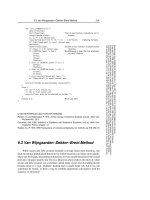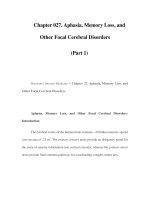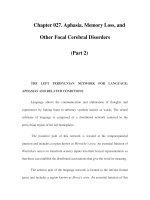Chapter 027. Aphasia, Memory Loss, and Other Focal Cerebral Disorders (Part 4) doc
Bạn đang xem bản rút gọn của tài liệu. Xem và tải ngay bản đầy đủ của tài liệu tại đây (14.32 KB, 5 trang )
Chapter 027. Aphasia, Memory Loss, and
Other Focal Cerebral Disorders
(Part 4)
Gestures and pantomime do not improve communication. The patient does
not seem to realize that his or her language is incomprehensible and may appear
angry and impatient when the examiner fails to decipher the meaning of a severely
paraphasic statement. In some patients this type of aphasia can be associated with
severe agitation and paranoid behaviors. One area of comprehension that may be
preserved is the ability to follow commands aimed at axial musculature. The
dissociation between the failure to understand simple questions ("What is your
name?") in a patient who rapidly closes his or her eyes, sits up, or rolls over when
asked to do so is characteristic of Wernicke's aphasia and helps to differentiate it
from deafness, psychiatric disease, or malingering. Patients with Wernicke's
aphasia cannot express their thoughts in meaning-appropriate words and cannot
decode the meaning of words in any modality of input. This aphasia therefore has
expressive as well as receptive components. Repetition, naming, reading, and
writing are also impaired.
The lesion site most commonly associated with Wernicke's aphasia is the
posterior portion of the language network and tends to involve at least parts of
Wernicke's area. An embolus to the inferior division of the middle cerebral artery,
and to the posterior temporal or angular branches in particular, is the most
common etiology (Chap. 364). Intracerebral hemorrhage, severe head trauma, or
neoplasm are other causes. A coexisting right hemi- or superior quadrantanopia is
common, and mild right nasolabial flattening may be found, but otherwise the
examination is often unrevealing. The paraphasic, neologistic speech in an agitated
patient with an otherwise unremarkable neurologic examination may lead to the
suspicion of a primary psychiatric disorder such as schizophrenia or mania, but the
other components characteristic of acquired aphasia and the absence of prior
psychiatric disease usually settle the issue. Some patients with Wernicke's aphasia
due to intracerebral hemorrhage or head trauma may improve as the hemorrhage
or the injury heals. In most other patients, prognosis for recovery is guarded.
Broca's Aphasia
Speech is nonfluent, labored, interrupted by many word-finding pauses, and
usually dysarthric. It is impoverished in function words but enriched in meaning-
appropriate nouns and verbs. Abnormal word order and the inappropriate
deployment of bound morphemes (word endings used to denote tenses,
possessives, or plurals) lead to a characteristic agrammatism. Speech is telegraphic
and pithy but quite informative. In the following passage, a patient with Broca's
aphasia describes his medical history: "I see . . . the dotor, dotor sent me . . .
Bosson. Go to hospital. Dotor . . . kept me beside. Two, tee days, doctor send me
home."
Output may be reduced to a grunt or single word ("yes" or "no"), which is
emitted with different intonations in an attempt to express approval or disapproval.
In addition to fluency, naming and repetition are also impaired. Comprehension of
spoken language is intact, except for syntactically difficult sentences with passive
voice structure or embedded clauses. Reading comprehension is also preserved,
with the occasional exception of a specific inability to read small grammatical
words such as conjunctions and pronouns. The last two features indicate that
Broca's aphasia is not just an "expressive" or "motor" disorder and that it may also
involve a comprehension deficit for function words and syntax. Patients with
Broca's aphasia can be tearful, easily frustrated, and profoundly depressed. Insight
into their condition is preserved, in contrast to Wernicke's aphasia. Even when
spontaneous speech is severely dysarthric, the patient may be able to display a
relatively normal articulation of words when singing. This dissociation has been
used to develop specific therapeutic approaches (melodic intonation therapy) for
Broca's aphasia. Additional neurologic deficits usually include right facial
weakness, hemiparesis or hemiplegia, and a buccofacial apraxia characterized by
an inability to carry out motor commands involving oropharyngeal and facial
musculature (e.g., patients are unable to demonstrate how to blow out a match or
suck through a straw). Visual fields are intact. The cause is most often infarction
of Broca's area (the inferior frontal convolution; "B" in Fig. 27-1) and surrounding
anterior perisylvian and insular cortex, due to occlusion of the superior division of
the middle cerebral artery (Chap. 364). Mass lesions including tumor, intracerebral
hemorrhage, or abscess may also be responsible. Small lesions confined to the
posterior part of Broca's area may lead to a nonaphasic and often reversible deficit
of speech articulation, usually accompanied by mild right facial weakness. When
the cause of Broca's aphasia is stroke, recovery of language function generally
peaks within 2–6 months, after which time further progress is limited.
Global Aphasia
Speech output is nonfluent, and comprehension of spoken language is
severely impaired. Naming, repetition, reading, and writing are also impaired. This
syndrome represents the combined dysfunction of Broca's and Wernicke's areas
and usually results from strokes that involve the entire middle cerebral artery
distribution in the left hemisphere. Most patients are initially mute or say a few
words, such as "hi" or "yes." Related signs include right hemiplegia, hemisensory
loss, and homonymous hemianopia. Occasionally, a patient with a lesion in
Wernicke's area will present with a global aphasia that soon resolves into
Wernicke's aphasia.









